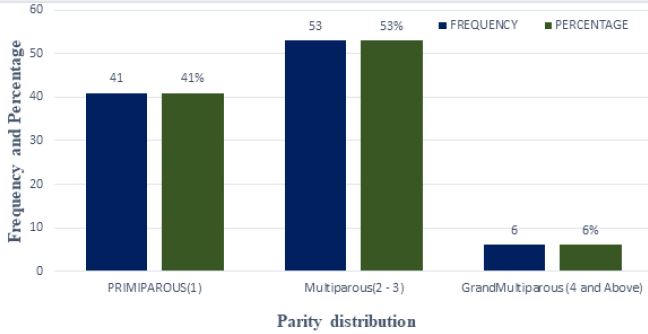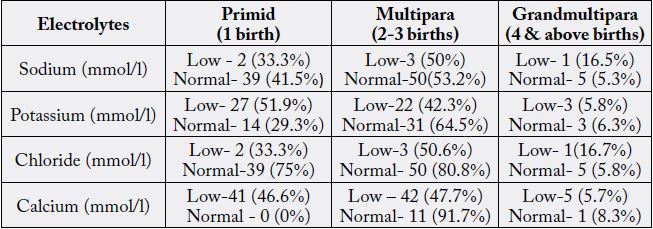Biography
Interests
Christiana Nkeiru Friday, Faith Diorgu, C.* & Anacletus Francis
African Center of Excellence for Public Health and Toxicological Research, University of Port Harcourt, Nigeria
*Correspondence to: Dr. Faith Diorgu, C., African Center of Excellence for Public Health and Toxicological Research, University of Port Harcourt, Nigeria.
Copyright © 2021 Dr. Faith Diorgu, C., et al. This is an open access article distributed under the Creative Commons Attribution License, which permits unrestricted use, distribution, and reproduction in any medium, provided the original work is properly cited.
Abstract
Electrolytes are mineral ions that have the capacity to conduct electrical charges when dissolved in
a solution like the blood. Its derangement during pregnancy is one of the most leading causes of
foeto- maternal morbidity and mortality.
This study is aimed at determining the status of electrolytes based on parity of pregnancy.
The study includes one hundred blood samples of pregnant women between age 20 to 42 years
attending antenatal care in four selected private Obstetric and Gynaecological hospitals in their
first, second and third trimesters of pregnancy.
There is no significant relationship (P > 0.05) between electrolytes concentration of pregnancy
and parity. Serum potassium and calcium were significantly low and occurred more in multiparous
women while sodium and chloride concentration across parity significantly normal.
Electrolytes are vital mineral ions that require maintenance to ensure positive outcome of pregnancy
as its derangement can be fatal. Therefore, its assessment during pregnancy is useful in the early
diagnosis of pregnancy related complications.
Introduction
Pregnancy affects every system of the body including the fluid and electrolytes balance. Electrolytes are
charged elements essential for biological processes of the body. Basic electrolytes in the body are sourced from
food and fluids consumed and they includes calcium, sodium, potassium and chloride and these electrolytes
are mainly affected by pregnancy. Derangement in any of these electrolytes may negatively affect the health
status of a person and can result to untoward event such as death. The electrolytes collaboratively function
to maintain the functionality of the cell membrane, nerve conduction, muscle integrity and also maintain
equilibrium within the fluid and acid-base balance. In a normal state of health, under normal processes the
balances in electrolytes are maintained. Nevertheless, there are chemical and physiological conditions such
as gastrointestinal illness, blood loss, respiratory diseases, neurological diseases or insufficient fluid intake
over a period of time that causes a derangement in electrolytes [1].
Hyponatremia is associated with increased morbidity and mortality [2]. Maternal Hyponatremia leads to similarly low neonatal sodium and this could result to neonatal respiratory disease syndrome, jaundice and lethargy [3]. Variation in maternal serum electrolytes is postulated to be the triggering cause of elevated blood pressure in pre-eclamptic women [4,5], potassium aids cellular metabolism, maintenance of blood pressure as a precursor of cardiac function, neuromuscular function and also transmission of nerve impulses [6,7]. Little alteration in potassium level can affect the rhythm of the heart and its ability to contract. During the first half of pregnancy, increase in potassium level can increase the chance of developing gestational diabetes and severe pre-eclampsia [8].
Multiparity may not pose any severe danger to health [9]. The design of the study is to determine the status of electrolytes based on the parity of pregnancy.
Materials and Methods
A total number of 100 pregnant women attending antenatal clinic in four (4) selected private hospitals were
recruited using their blood samples. They were between ages of 20 - 42 and at their various trimesters of pregnancy. Participants were booked clients with normal baseline booking laboratory parameters. Those with
hypertension, diabetic, anaemia, participants with history of vomiting, hyperemesis gravidarum, diarrhoea,
renal complications burns and chronic alcoholism were excluded.
Data and Blood Sample Collection
Demographic data (age, parity and trimesters) were obtained from the laboratory request forms as discussed
with the consulting gynaecologist and midwives. Blood samples were collected from the antecubital vein
into lithium heparin sample bottle for determination of the electrolytes status.
Three (3mls) of blood samples were collected from the anticubital vein of each participant by standard
aseptic techniques into lithium heparin sample bottle. The blood samples were allowed to clot and separate
and about 1ml of serum used to analyse for electrolytes. Serum sodium, potassium, calcium and chloride
status were determines using an automated blood gas and electrolytes analyzer (OPTI CCA TS 2) model
OP6-002052 OPTI medical system, USA.
Statistical Analysis
Data were analysed and presented in percentage and frequency distribution tables and bar charts. Hypothesis
was tested using chi-square at P value of <0.05 was considered statistically significant. The analysis was
supported by Statistical Package for Social Sciences (SPSS) version 20.0.
Results
The ages of participants were between 20 - 42 years. There was no significant relationship (P >0.05) between
serum electrolytes concentration and parity.



The result revealed that out of the 94 (94%) normal sodium concentration level across the three trimesters of pregnancy, 39 (41.5%) were primiparous women, 50 (53.2%) were multiparous women while 5 (5.3%) were grand multiparous women. Furthermore, of the total 6(6%) with low sodium level, 2 (33.3%) were in the primiparous group while 3 (50%) were multiparous while 1 (16.7%) were grand multiparous women. The result also analyzed for potassium of which of the 52 (52%) of low potassium concentration, 27 (51.9%) were primiparous, 22 (42.3%) were multiparous while grand multiparous women were 3 (5.8%). From the result also, of the 48(48%) normal potassium concentration, 14(29.2%) were primiparous, 31(66.5%) were multiparous while 3(6.3%) were grand multiparous women. The result further showed the chloride concentration level across the parity. From the study, 6 (6%) participants were with Low calcium concentration level, 2 (33.3%) were primiparous pregnant women, 3 (50%) of them were multiparous and 1 (16.7%) were grand multiparous. Also, the total number of respondents with normal level of chloride was 86 (86%), 33 (38.4%) of which were primiparous women, 48 (55.8%) were multiparous and 5 (5.8%) were of grand multiparous group. Finally, 8 (8%) blood samples of respondents had high chloride level, 6 (75%) were primiparous and 2 (25%) were multiparous. Participants blood sample with low calcium concentration level was 88 (88%), of which 41(46.6%) were primiparous, 42 (47.7%) multiparous and 5 (5.7%) grand multiparous. Of the 12 samples with normal calcium concentration, 11 (91.7%) were multiparous, 1(8.3%) were grand multiparous while all the primiparous group have low calcium. From the finding, most multiparous group had more electrolytes imbalance than the primiparous and grand multiparous women and the most affected electrolytes across the parity was calcium 88(88%) followed by potassium 52 (52%) before chloride and then sodium which is the least affected.
Discussion
Pregnancy affects every system of the body including salt and water balance. In an attempt so meet up with
the foeto-maternal needs during pregnancy, the maternal body accumulates electrolytes, fluids and nutrients.
The associated conditions such as vomiting, diarrhoea, excessive urination, sweating, peculiar to pregnancy
depletes the electrolytes in pregnancy predisposing the pregnant women to varying degree of health challenges
ranging from minor to major complications like pre-eclampsia. Sodium, calcium, potassium and chloride are
major electrolytes necessary for regulation of vital body functions. Irrespective of the parity of a woman, each
pregnancy is unique with its attendants problems and physiological changes that could endanger the life of
the woman and her baby. Too much sodium during pregnancy can result to excessive fluid retention in the
body manifesting as oedema, this can predispose to other health conditions that can complicate pregnancy
[7]. Hypernatremia which clinically manifest as confusion, increased thirst, fatigue muscle twitching and
irritability, restlessness, reduces urinary output, vomiting and diarrhoea [6] in a more severe case irrespective
of the parity can dehydrate the brain cells resulting to complications like haemorrhage, seizure, coma and
even death if not properly managed [6,10].
This study revealed that the multiparous group had more electrolytes imbalance than the primiparous and grand multiparous group as opposed to the finding of a study [9]. Whose study opined that there was no significant difference in blood pressure among the group and between trimesters in the pregnant groups regardless of their parity. Hence suggesting that multiparity may not affect electrolytes concentration patterns. The study also reported no significant relationship between parity and the electrolytes status of pregnancy across the three trimesters. This is indicating that multiparity may affects the status of electrolytes, which could be associated with short - term pregnancies, poverty, illiteracy and poor nutritional status of pregnant women due to large family size.
Conclusion
The present study concluded that there is no significant relationship between parity and electrolytes
concentration showing that multiparous women had more electrolyte imbalance then the other group of
primiparous and grand multiparous. However, there is need for further studies and based on the results,
multiparous women are adviced to eat right and space their children adequately.
Bibliography

Hi!
We're here to answer your questions!
Send us a message via Whatsapp, and we'll reply the moment we're available!